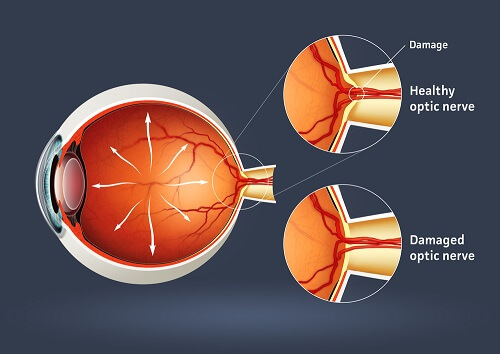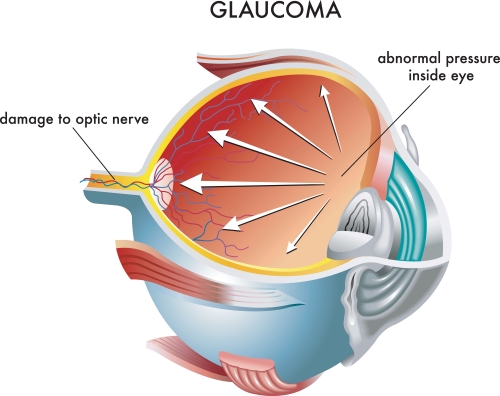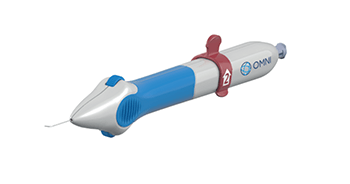
Glaucoma is part of a group of diseases of the optic nerve involving loss of retinal ganglion cells in a characteristic pattern of optic neuropathy. Raised intraocular pressure is a significant risk factor for developing glaucoma (above 22mmHg). One person may develop nerve damage at a relatively low pressure, while another person may have high eye pressure for years and yet never develop damage. Untreated glaucoma leads to permanent damage of the optic nerve and resultant visual field loss, which can progress to blindness.
Glaucoma can be divided roughly into two main categories, “open angle” or chronic Glaucoma and “closed angle” or acute glaucoma. Angle closure, acute glaucoma appears suddenly and often with painful side effects and so is usually diagnosed quickly, although damage and loss of vision can also occur very suddenly. Open angle, chronic glaucoma tends to progress more slowly and so the patient may not notice it until the disease has progressed quite significantly.
Glaucoma has been nicknamed the “sneak thief of sight” because the loss of visual field often occurs gradually over a long time and may only be recognized when it is already quite advanced. Once lost, this damaged visual field can never be recovered. Worldwide, it is the second leading cause of blindness. Glaucoma affects one in two hundred people aged fifty and younger and one in ten over the age of eighty.
Glaucoma Treatment and Technology
Our experienced and professional eye surgeons at Laurel Eye Clinic are dedicated to providing you with the most advanced glaucoma treatment and procedures available. You can trust that at Laurel Eye Clinic, our eye surgeons will be able to offer you the best comprehensive glaucoma care possible.
What is Glaucoma?
Glaucoma is an eye condition that can cause progressive vision loss over time if left untreated. Glaucoma is caused by high levels of pressure inside the eye.
Your eye is constantly creating fluid. The fluid must drain from the eye at a consistent rate for the pressure to remain in the normal range.
If your eye produces too much fluid or if the fluid cannot properly drain from the eye, your eye pressure will increase. When your eye pressure is consistently high, it can damage the optic nerve at the back of your eye.
The optic nerve is responsible for transmitting information to your brain to produce an image for you to see. Damage to your optic nerve can cause permanent vision changes.
Glaucoma is treatable and best if caught in the early stages. Your experienced eye surgeon at Laurel Eye Clinic can treat glaucoma with various methods.
All glaucoma procedures and treatments aim to lower eye pressure and preserve eyesight.

Kahook Dual Blade Treatment
The Kahook Dual Blade treatment is another minimally invasive approach that aims to reduce eye pressure in adults with open-angle glaucoma. The Kahook Dual Blade procedure does not include the use of an implant.
Instead of implanting a device for the fluid to bypass the drainage system, eye surgeons use the Kahook Dual Blade to remove a portion of the eye’s natural drainage system. Before the fluid can reach the canal where it drains from the eye, it must go through a meshwork system called the trabecular meshwork.
The trabecular meshwork is often where the blockage or restriction occurs. A blockage in this area can lead to increased eye pressure.
Eye surgeons use the Kahook Dual Blade to remove a portion of the trabecular meshwork. Removing a part of this meshwork increases the fluid’s flow rate out of the eye.
Your eye surgeon at Laurel Eye Clinic can also perform the Kahook Dual Blade procedure at the time of cataract surgery. First, your eye surgeon will numb your eyes with a numbing drop.
If you have cataract surgery simultaneously, they may perform cataract surgery before or after using the Kahook Dual Blade, depending on their preference. First, your eye surgeon will make a tiny incision in your cornea.
Then, they will insert the Kahook Dual Blade into the trabecular meshwork in your eye. Your eye surgeon will then remove a portion of this meshwork and open up the eye’s natural drainage channel.
After this, they will remove the Kahook Dual Blade from your eye. The tiny incision will naturally heal on its own.
The procedure is quick, recovery time is minimal, and you can go home the same day. Your eye surgeon will give you instructions on how to help your eyes heal.
OMNI Surgical System

The OMNI Surgical System is another safe and minimally invasive glaucoma surgery that helps lower eye pressure. Eye surgeons use the OMNI Surgical System primarily on adult patients with open-angle glaucoma to increase the outflow of fluid.
The OMNI Surgical System works to increase the outflow by opening the channel in the eye’s natural drainage system and restoring flow to areas that may be blocked or restricted. Similar to the Kahook Dual Blade procedure, the OMNI Surgical System procedure does not include the use of an implant.
The OMNI Surgical System procedure can also be performed at the same time as cataract surgery. This makes it an ideal choice for those that need a pressure-lowering procedure and cataract surgery.
One of the main goals during glaucoma treatment is to increase the outflow of fluid. In an eye with glaucoma, the fluid cannot flow at a normal rate out of the eye due to a blockage or clog in the drain.
The OMNI Surgical System helps your eye surgeon relieve pressure buildup in the eye by removing unnecessary blockages. First, your eye surgeon will numb your eye with eye drops.
Next, they will make a tiny incision in your cornea. Through this tiny incision, your eye surgeon will insert the OMNI Surgical System.
Then they will place it in your eye’s natural drainage system. Your eye surgeon at Laurel Eye Clinic will then use the OMNI Surgical System to address three different areas where blockages occur in the natural outflow pathway.
Addressing all three areas will allow better fluid outflow and lower the eye pressure. If you are having cataract surgery at the same time, your eye surgeon can perform the OMNI Surgical System procedure before or after completing the cataract surgery.
After the procedure is complete, the incision on your cornea will heal on its own without the need for stitches. The OMNI Surgical System procedure is quick, lasting only a few minutes.
In addition to it being a very safe procedure, it has proven to be very effective in lowering eye pressure.
Are you interested in learning more about the glaucoma technology and treatment options available at Laurel Eye Clinic? Schedule an appointment at Laurel Eye Clinic today!

